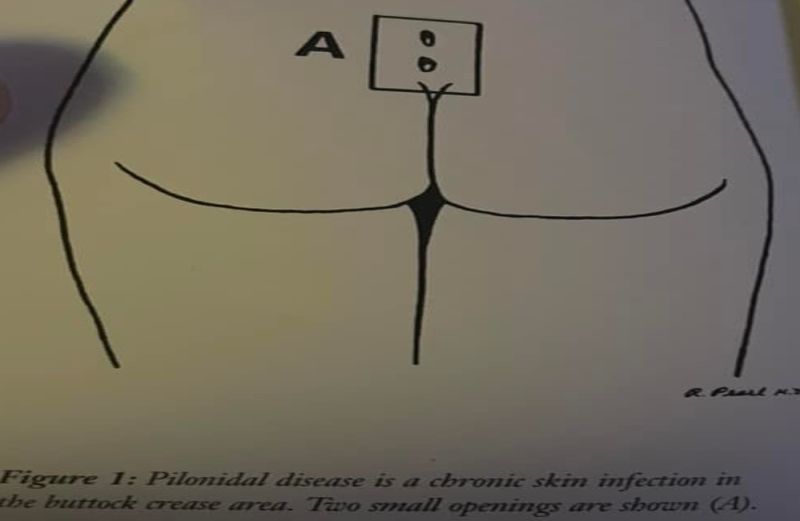Pilonidal Sinus Disease
Pilonidal sinus disease (PSD) is a surgical-dermatological condition which is associated with a number of misconceptions - Dietrich Doll

image by: Kris Aten
HWN Recommends
Pilonidal Abscess: The Very Bare (Back) Basics
Patients often present to the emergency department embarrassed and unsure of their diagnosis. They think they are doing something wrong, are unclean, or do not wash themselves well. This is not the case, and it is important to assure them they did not cause their ailment. Patients mainly complain of pain over their spine or above their buttock, redness or swelling over the area, discharge, and if infected, fever, nausea, or possible signs and symptoms of sepsis.
Many theories explain why some people develop pilonidal cysts or abscesses. Occasionally they occur due to ingrown hairs or infected hair follicles. Another theory is that pilonidal cysts appear after trauma to that region…
Resources
 The PITSTOP study
The PITSTOP study
The ideal management of PD should be simple, safe, cost effective, easy to perform and lead to a rapid return to normal activities, with low rates of acute wound complications (including infection, seroma, haematoma), recurrence, and rapid wound healing. These aims are not reliably delivered by current surgical practice and there is no consensus on how to manage based on disease characteristics. We propose a prospective cohort study to determine the sub types of pilonidal disease, to describe the various interventions, to engage with patients and to determine which outcomes they value and which interventions they prefer/do not prefer and to provide recommendations for further research.
 Rethinking the causes of pilonidal sinus disease: a matched cohort study
Rethinking the causes of pilonidal sinus disease: a matched cohort study
Pilonidal sinus disease (PSD) is a surgical-dermatological condition which is associated with a number of misconceptions. It is an acute or chronic infection of the subcutis responsible for an ever-increasing share of operations, mostly in young males. Our understanding of pilonidal sinus disease (PSD) is based on a paper published 29 years ago by Karydakis. Since then, surgeons have been taught that hair more easily penetrates wet skin, leading to the assumption that sweating promotes PSD. This postulate, however, has never been proven.
Current trends in the management of pilonidal sinus disease and its outcome in a periphery hospital
Its pathophysiology is debatable as it has been commonly thought to be embryonic; however, currently it is accepted to be an acquired pathology with multiple contributing factors.
Get your Pilonidal Disease treated by an expert
I advised a repeat Cleft Lift procedure. The operation was challenging but went well and Andrew had an excellent outcome.
Pilonidal Disease
Pilonidal disease presents many therapeutic challenges to surgeons throughout the world. Its varied clinical presentations necessitate a wide range of treatments, thus underscoring the need to tailor the treatment to the patient and the severity of disease.
Pilonidal Sinus
It is hypothesized that hair in the gluteal cleft creates a foreign body reaction that ultimately leads to the formation of a pit and may then subsequently develop a secondary infection. Factors that predispose individuals to developing pilonidal sinus disease include male gender, dark skin, deep gluteal cleft, obesity, young age, local trauma, sedentary lifestyle, and increased hair density in the gluteal cleft.
Pilonidal sinus disease: a misunderstood problem
Pilonidal sinus disease, although relatively rare, is still poorly understood both in terms of pathophysiology or the best treatment options. The incidence is thought to be 26 per 100,000 and is 2.2 times more common in males. Morbidity is high in these young adults with a disease process exceeding 3 years.
What You Should Remember in Managing Pilonidal Disease
Actually PSD has a wide spectrum of presentations ranging from minimally symptomatic pits at the natal cleft to massive abscess formation with or without complex tracts and fistulas.
 Pilonidal Abscess: The Very Bare (Back) Basics
Pilonidal Abscess: The Very Bare (Back) Basics
It’s time to stop packing pilonidal cysts. We challenge you to try a new approach if you have not already!
International Pilonidal Society
Connecting patients and specialist surgeons to deliver quality outcomes for those with pilonidal disease.
The Pilonidal Support Alliance
We provide articles, abstracts, pictures, surgical techniques and research to those wanting to know more about the condition. We also provide a web-based discussion group for exchange of ideas, information, experiences and a place for people to turn when they need reassurance. We have created a community that educates people and allowed them to become a full partner in their medical care.
Boston Pilonidal Center
There are many different presentations for pilonidal disease and many different treatment options. This site was created to simplify the process of learning about the options we specialize in, specifically the cleft lift procedure.
NHS
A pilonidal sinus is a small hole or tunnel in the skin at the top of the buttocks, where they divide (the cleft). It does not always cause symptoms and only needs to be treated if it becomes infected.
Wound Source
A pilonidal cyst is a pimple-like cyst typically located in the sacrococcygeal region of the body, usually near the top of the intergluteal cleft (also referred to as the natal cleft). Rarely, pilonidal cysts may also manifest between digits.

Introducing Stitches!
Your Path to Meaningful Connections in the World of Health and Medicine
Connect, Collaborate, and Engage!
Coming Soon - Stitches, the innovative chat app from the creators of HWN. Join meaningful conversations on health and medical topics. Share text, images, and videos seamlessly. Connect directly within HWN's topic pages and articles.













